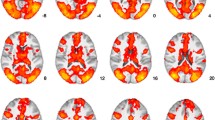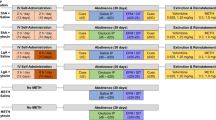Abstract.
Brain noradrenergic systems have been shown to be altered in opioid dependence and to mediate aspects of opioid withdrawal. Pre-clinical and clinical studies by others have shown that yohimbine, which increases noradrenergic activity, also increases both baseline and fear enhancement of the magnitude of the acoustic startle response (ASR). In a separate report from this experiment, it was shown that yohimbine produced opioid withdrawal-like symptoms, including anxiety, in clinically stable methadone-maintained patients and also produced elevations in the norepinepherine (NE) metabolite, 3-methoxy-4 hydroxyphenethyleneglycol (MHPG), and cortisol serum levels. The current study reports the effects of intravenous yohimbine hydrochloride, 0.4 mg/kg versus saline (double-blind), on ASR magnitude, plasma MHPG, and cortisol levels in eight methadone-maintained patients and 13 healthy subjects in a double-blind fashion. Yohimbine increased startle magnitude in both groups. There was no basal (placebo day) difference between the startle response of the two groups, but methadone patients had a larger startle magnitude increase in response to yohimbine than healthy controls. Methadone-maintained patients had lower baseline plasma levels of MHPG and similar baseline plasma cortisol levels compared with normal subjects. Yohimbine caused significant elevation in cortisol and MHPG in both groups. Methadone-maintained subjects had higher elevations in cortisol levels and MHPG (methadone main effect) levels in response to yohimbine. However, when MHPG levels were corrected for baseline differences by analysis of covariance (ANCOVA), the yohimbine effect, but not the methadone effect remained statistically significant. These results are consistent with the previous report and support the hypothesis that abnormalities of the hypothalamic-pituitary-adrenal (HPA) axis and of noradrenergic mechanisms of stress response persist in opioid-agonist maintenance. The ASR effect extends the previous report and provides an additional objective measure for perturbation of noradrenergic and stress responses in these patients.
Similar content being viewed by others
Author information
Authors and Affiliations
Additional information
Electronic Publication
Rights and permissions
About this article
Cite this article
Stine, S., Grillon, C., Morgan III, C. et al. Methadone patients exhibit increased startle and cortisol response after intravenous yohimbine. Psychopharmacology 154, 274–281 (2001). https://doi.org/10.1007/s002130000644
Received:
Accepted:
Issue Date:
DOI: https://doi.org/10.1007/s002130000644




